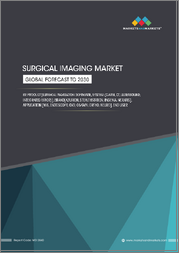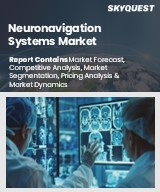
|
시장보고서
상품코드
1725127
세계의 외과용 내비게이션 시스템 시장 : 컴포넌트, 기술, 용도, 최종 사용자, 지역별 분석, 예측(-2032년)Surgical Navigation Systems Market Forecasts to 2032 - Global Analysis By Component (Navigation Systems/Hardware, Navigation Software, Instruments & Accessories and Other Components), Technology, Application, End User and By Geography |
||||||
Stratistics MRC에 따르면 세계 외과용 내비게이션 시스템 시장은 2025년 96억 달러, 예측 기간 동안 CAGR은 16.2%를 나타낼 전망이며, 2032년에는 275억 달러에 이를 전망입니다.
외과용 내비게이션 시스템은 복잡한 수술 중에 외과의사가 기구를 정확하게 유도하는 데 도움이 되는 고급 의료 기술입니다. 신경외과, 정형외과, 최소 침습 시술에서 흔히 사용되는 이 제품들은 섬세한 구조물을 자신 있게 탐색하는 데 도움을 줍니다. 기술이 발전함에 따라 외과용 내비게이션 시스템은 현대의 건강 관리를 재정의하고, 더욱 안전하고 효과적인 개입을 가능하게 하는 동시에 환자의 합병증과 회복 시간을 최소화합니다.
E-Clinical Medicine 2020에 게재된 논문에 따르면 15세 이상의 변형성 무릎관절증(OA)의 유병률은 16%, 40세 이상의 유병률은 22.9%였습니다.
낮은 침습 수술 증가
환자의 회복과 입원 기간의 단축이 중시되고 있으며, 낮은 침습 수술이 큰 지지를 모으고 있습니다. 수술용 내비게이션 시스템은 복잡한 시술 중 정밀도를 향상시켜 결과를 개선하는 데 중요한 역할을 합니다. 낮은 침습 접근 방식에 대한 선호도 증가는 외과의사를 실시간으로 지원하는 고급 네비게이션 기술에 대한 수요를 촉진할 것으로 예측됩니다.
복잡한 통합
외과용 내비게이션 시스템은 헤아릴 수 없는 이점을 가져오는 한편, 기존의 헬스케어 인프라에의 통합에는 과제가 있습니다. 완벽한 호환성이 요구되고 있으며, 이러한 시스템을 효율적으로 운영하기 위한 의료 종사자의 훈련도 복잡성을 증가시키고 있습니다.
로봇 지원 수술(RAS) 시스템 채용 증가
로봇 지원 수술 플랫폼의 급속한 확장은 내비게이션 시스템 제공업체에게 유리한 기회를 제공합니다. 플랫폼과 통합된 내비게이션 시스템은 해부학적 구조의 시각화를 개선하고 정확한 개입을 촉진합니다.
노후화로 이어지는 급속한 기술 발전
외과용 내비게이션 시스템의 기술 혁신 속도는 가속화되고 있으며 기존 모델이 단기간에 구식이 되는 경우가 많습니다. 잦은 업그레이드와 진화하는 기능으로 인해 의료 서비스 제공업체는 새로운 버전에 지속적으로 투자해야 하므로 재정적 부담이 증가합니다. 또한 AI 주도의 실시간 수술 지침 도구의 출현으로 기존의 내비게이션 시스템이 가려져 시장의 관련성이 저하될 가능성이 있습니다.
COVID-19의 영향 :
COVID-19의 유행은 외과용 내비게이션 시스템 시장에 긍정적이고 부정적인 영향을 미쳤습니다. 원격 의료와 원격 수술 지도가 주목받으며 첨단 디지털 솔루션의 개발로 이어졌습니다.
예측 기간 동안 내비게이션 소프트웨어 분야가 최대화될 전망
내비게이션 소프트웨어 분야는 수술의 정확성과 수술의 효율성을 높일 수 있기 때문에 예측 기간 동안 최대 시장 점유율을 차지할 것으로 예측됩니다. 외과의사들은 수술 중 정확한 결정을 내리기 위해 실시간 이미지 안내, 통합된 수술 전 데이터, 그리고 예측 알고리즘에 의존합니다. 로봇 시스템과 AI 주도형 플랫폼과의 호환성을 제공하는 소프트웨어 주도형 내비게이션 툴의 지속적인 진화가 다양한 수술 분야에서의 보급에 더욱 기여하고 있습니다.
예측 기간 동안 하이브리드 내비게이션 시스템 분야의 CAGR이 가장 높을 것으로 예상
예측 기간 동안 하이브리드 내비게이션 시스템 분야가 가장 높은 성장률을 보일 것으로 예측됩니다. 하이브리드 시스템의 적응성과 범용성은 여러 수술 기술과의 원활한 통합을 가능하게 하고 수요를 견인하고 있습니다.
최대 공유 지역 :
예측기간 동안 북미는 확립된 헬스케어 인프라, 선진의료기술, 강력한 업계현재로 최대 시장 점유율을 차지할 것으로 예측됩니다. 이 지역의 선도적인 기업들은 혁신적인 수술 내비게이션 솔루션을 도입하기 위해 지속적으로 연구 개발에 투자하고 있습니다.복잡한 수술의 보급률이 높고 로봇 지원 수술의 채용이 증가하고 있는 것도 시장의 지속적인 성장에 기여하고 있습니다.
CAGR이 가장 높은 지역 :
예측 기간 동안 아시아태평양은 급속한 의료 진보와 의료 기술 투자 증가로 인해 가장 높은 CAGR을 나타낼 것으로 예측됩니다. 정밀 내비게이션 시스템 수요를 끌어 올리고 있습니다. 헬스 케어 액세스와 수술 기술 혁신을 촉진하는 정부의 대처가 시장 확대를 한층 더 가속해, 이 지역을 중요한 성장 거점으로 하고 있습니다.
무료 주문을 받아서 만드는 서비스:
이 보고서를 구독하는 고객은 다음 무료 맞춤설정 옵션 중 하나를 사용할 수 있습니다.
- 기업 프로파일
- 추가 시장 기업의 종합적 프로파일링(3개사 까지)
- 주요 기업의 SWOT 분석(3개사 까지)
- 지역 세분화
- 고객의 관심에 응한 주요국 시장 추정, 예측 및 CAGR(주: 타당성 확인에 따름)
- 경쟁 벤치마킹
- 제품 포트폴리오, 지리적 존재, 전략적 제휴에 기반한 주요 기업 벤치마킹
목차
제1장 주요 요약
제2장 서문
- 개요
- 이해관계자
- 조사 범위
- 조사 방법
- 데이터 마이닝
- 데이터 분석
- 데이터 검증
- 조사 접근
- 조사 자료
- 1차 조사 자료
- 2차 조사 정보원
- 전제조건
제3장 시장 동향 분석
- 성장 촉진요인
- 억제요인
- 기회
- 위협
- 기술 분석
- 용도 분석
- 최종 사용자 분석
- 신흥 시장
- COVID-19의 영향
제4장 Porter's Five Forces 분석
- 공급기업의 협상력
- 구매자의 협상력
- 대체품의 위협
- 신규 참가업체의 위협
- 경쟁 기업간 경쟁 관계
제5장 세계의 수술 내비게이션 시스템 시장 : 컴포넌트별
- 내비게이션 시스템, 하드웨어
- 내비게이션 소프트웨어
- 기기와 액세서리
- 기타 컴포넌트
제6장 세계의 외과용 내비게이션 시스템 시장 : 기술별
- 전자 항행 시스템
- 광학 항법 시스템
- 투시 기반 내비게이션 시스템
- CT 기반 내비게이션 시스템
- MRI 기반 내비게이션 시스템
- 하이브리드 내비게이션 시스템
- 기타 기술
제7장 세계의 외과용 내비게이션 시스템 시장 : 용도별
- 뇌신경외과
- 정형외과
- 척추 수술
- 치과 외과
- 심장혈관 수술
- 이비인후과 수술
- 기타 용도
제8장 세계의 외과용 내비게이션 시스템 시장 : 최종 사용자별
- 병원
- 전문 클리닉
- 외래수술센터(ASC)
제9장 세계의 외과용 내비게이션 시스템 시장 : 지역별
- 북미
- 미국
- 캐나다
- 멕시코
- 유럽
- 독일
- 영국
- 이탈리아
- 프랑스
- 스페인
- 기타 유럽
- 아시아태평양
- 일본
- 중국
- 인도
- 호주
- 뉴질랜드
- 한국
- 기타 아시아태평양
- 남미
- 아르헨티나
- 브라질
- 칠레
- 기타 남미
- 중동 및 아프리카
- 사우디아라비아
- 아랍에미리트(UAE)
- 카타르
- 남아프리카
- 기타 중동 및 아프리카
제10장 주요 발전
- 계약, 파트너십, 협업, 합작투자
- 인수와 합병
- 신제품 발매
- 사업 확대
- 기타 주요 전략
제11장 기업 프로파일링
- 7D Surgical
- Amplitude Surgical SA
- B. Braun Melsungen AG
- Brainlab AG
- Cascination AG
- DePuy Synthes
- Fiagon AG Medical Technologies
- Intersect ENT
- Karl StorzGmBH&Co. KG
- Medtronic PLC
- OrthAlign, Inc.
- ScopisGmBH
- Siemens Aktiengesellschaft
- Stryker Corporation
- Zimmer Biomet Holdings, Inc.
- Corin Group
- Smith Nephew
According to Stratistics MRC, the Global Surgical Navigation Systems Market is accounted for $9.6 billion in 2025 and is expected to reach $27.5 billion by 2032 growing at a CAGR of 16.2% during the forecast period. Surgical navigation systems are advanced medical technologies that assist surgeons in accurately guiding instruments during complex procedures. These systems use imaging techniques like CT, MRI, or real-time tracking to create a detailed map of the surgical area. By providing precise, real-time data, they enhance accuracy, reduce risks, and improve patient outcomes. Commonly used in neurosurgery, orthopedics, and minimally invasive procedures, they help navigate delicate structures with confidence. Integrating AI and robotics further optimizes precision. As technology advances, surgical navigation continues to redefine modern healthcare, enabling safer and more effective interventions while minimizing complications and recovery time for patients.
According to the article published in the E-Clinical Medicine 2020, for people aged 15 and up, the prevalence of knee osteoarthritis (OA) was 16%, while in people aged 40 and above, the prevalence was 22.9%.
Market Dynamics:
Driver:
Rising adoption of minimally invasive surgeries
With the increasing focus on patient recovery and reduced hospital stays, minimally invasive surgical procedures are gaining significant traction. Healthcare professionals are prioritizing techniques that limit tissue damage, lower post-surgical complications, and shorten recovery time. Surgical navigation systems play a crucial role in enhancing precision during complex procedures, leading to improved outcomes. The growing preference for minimally invasive approaches is expected to drive the demand for advanced navigation technologies that assist surgeons in real-time.
Restraint:
Complexity of integration
While surgical navigation systems offer immense benefits, their integration into existing healthcare infrastructures presents challenges. Hospitals and surgical centers often struggle with interoperability issues, requiring seamless compatibility with imaging devices, robotic systems, and other surgical tools. Additionally, training medical professionals to efficiently operate these systems adds to the complexity. High installation costs and the need for specialized maintenance further hinder widespread adoption, slowing market growth.
Opportunity:
Increasing adoption of robotic-assisted surgery (RAS) systems
The rapid expansion of robotic-assisted surgical platforms presents lucrative opportunities for navigation system providers. Surgeons worldwide are leveraging robotics to enhance precision, minimize human error, and ensure greater control over procedures. Navigation systems integrated with robotic platforms improve the visualization of anatomical structures, facilitating accurate interventions. As hospitals and surgical centers continue investing in advanced robotic solutions, demand for sophisticated navigation technologies is expected to surge.
Threat:
Rapid technological advancements leading to obsolescence
The pace of technological innovation in surgical navigation systems is accelerating, often making existing models obsolete within short periods. Frequent upgrades and evolving features push healthcare providers to continuously invest in newer versions, increasing financial burdens. Additionally, the emergence of AI-driven, real-time surgical guidance tools may overshadow traditional navigation systems, reducing their market relevance.
Covid-19 Impact:
The COVID-19 pandemic had both positive and negative effects on the surgical navigation systems market. While elective surgeries experienced delays due to healthcare prioritization of critical cases, the crisis also underscored the importance of precision tools in medical interventions. Telemedicine and remote surgical guidance gained prominence, leading to the development of advanced digital solutions. As healthcare systems recovered, the adoption of navigation-assisted procedures increased, highlighting their role in improving surgical efficiency and outcomes.
The navigation software segment is expected to be the largest during the forecast period
The navigation software segment is expected to account for the largest market share during the forecast period due to its ability to enhance surgical accuracy and procedural efficiency. Surgeons rely on real-time image guidance, integrated preoperative data, and predictive algorithms to make precise decisions during operations. The continuous evolution of software-driven navigation tools, offering compatibility with robotic systems and AI-driven platforms, further contributes to its widespread adoption across various surgical disciplines.
The hybrid navigation systems segment is expected to have the highest CAGR during the forecast period
Over the forecast period, the hybrid navigation systems segment is predicted to witness the highest growth rate These systems combine optical, electromagnetic, and robotic navigation methodologies, providing surgeons with comprehensive guidance in real-time. The adaptability and versatility of hybrid systems allow seamless integration with multiple surgical technologies, driving demand. Their ability to enhance procedural accuracy and optimize patient outcomes positions them as the fastest-growing market.
Region with largest share:
During the forecast period, the North America region is expected to hold the largest market share due to its well-established healthcare infrastructure, advanced medical technologies, and strong industry presence. Leading companies in the region continuously invest in research and development to introduce innovative surgical navigation solutions. The high prevalence of complex surgical procedures, coupled with increased adoption of robotic-assisted surgeries, contributes to sustained market growth.
Region with highest CAGR:
Over the forecast period, the Asia Pacific region is anticipated to exhibit the highest CAGR driven by rapid healthcare advancements and increasing investments in medical technology. Countries such as China, India, and Japan are witnessing a surge in surgical interventions, boosting demand for precision navigation systems. Government initiatives promoting healthcare accessibility and surgical innovation further accelerate market expansion, making the region a key growth hub.
Key players in the market
Some of the key players in Surgical Navigation Systems Market include 7D Surgical, Amplitude Surgical SA, B. Braun Melsungen AG, Brainlab AG, Cascination AG, DePuy Synthes, Fiagon AG Medical Technologies, Intersect ENT, Karl StorzGmBH&Co. KG, Medtronic PLC, OrthAlign, Inc., ScopisGmBH, Siemens Aktiengesellschaft, Stryker Corporation, Zimmer Biomet Holdings, Inc., Corin Group and Smith+Nephew.
Key Developments:
In March 2025, India's Zydus Lifesciences announced plans to acquire an 85.6% stake in Amplitude Surgical for €256.8 million, aiming to expand its presence in the global medical devices market.
In February 2025, Zimmer Biomet Holdings, Inc. announced plans to acquire Paragon 28, a maker of orthopedic surgical devices, for approximately $1.1 billion to enhance its range of products.
Components Covered:
- Navigation Systems/Hardware
- Navigation Software
- Instruments & Accessories
- Other Components
Technologies Covered:
- Electromagnetic Navigation Systems
- Optical Navigation Systems
- Fluoroscopy-based Navigation Systems
- CT-based Navigation Systems
- MRI-based Navigation Systems
- Hybrid Navigation Systems
- Other Technologies
Applications Covered:
- Neurosurgery
- Orthopedic Surgery
- Spinal Surgery
- Dental Surgery
- Cardiovascular Surgery
- ENT Surgery
- Other Applications
End Users Covered:
- Hospitals
- Specialty Clinics
- Ambulatory Surgical Centers (ASCs)
Regions Covered:
- North America
- US
- Canada
- Mexico
- Europe
- Germany
- UK
- Italy
- France
- Spain
- Rest of Europe
- Asia Pacific
- Japan
- China
- India
- Australia
- New Zealand
- South Korea
- Rest of Asia Pacific
- South America
- Argentina
- Brazil
- Chile
- Rest of South America
- Middle East & Africa
- Saudi Arabia
- UAE
- Qatar
- South Africa
- Rest of Middle East & Africa
What our report offers:
- Market share assessments for the regional and country-level segments
- Strategic recommendations for the new entrants
- Covers Market data for the years 2024, 2025, 2026, 2028, and 2032
- Market Trends (Drivers, Constraints, Opportunities, Threats, Challenges, Investment Opportunities, and recommendations)
- Strategic recommendations in key business segments based on the market estimations
- Competitive landscaping mapping the key common trends
- Company profiling with detailed strategies, financials, and recent developments
- Supply chain trends mapping the latest technological advancements
Free Customization Offerings:
All the customers of this report will be entitled to receive one of the following free customization options:
- Company Profiling
- Comprehensive profiling of additional market players (up to 3)
- SWOT Analysis of key players (up to 3)
- Regional Segmentation
- Market estimations, Forecasts and CAGR of any prominent country as per the client's interest (Note: Depends on feasibility check)
- Competitive Benchmarking
- Benchmarking of key players based on product portfolio, geographical presence, and strategic alliances
Table of Contents
1 Executive Summary
2 Preface
- 2.1 Abstract
- 2.2 Stake Holders
- 2.3 Research Scope
- 2.4 Research Methodology
- 2.4.1 Data Mining
- 2.4.2 Data Analysis
- 2.4.3 Data Validation
- 2.4.4 Research Approach
- 2.5 Research Sources
- 2.5.1 Primary Research Sources
- 2.5.2 Secondary Research Sources
- 2.5.3 Assumptions
3 Market Trend Analysis
- 3.1 Introduction
- 3.2 Drivers
- 3.3 Restraints
- 3.4 Opportunities
- 3.5 Threats
- 3.6 Technology Analysis
- 3.7 Application Analysis
- 3.8 End User Analysis
- 3.9 Emerging Markets
- 3.10 Impact of Covid-19
4 Porters Five Force Analysis
- 4.1 Bargaining power of suppliers
- 4.2 Bargaining power of buyers
- 4.3 Threat of substitutes
- 4.4 Threat of new entrants
- 4.5 Competitive rivalry
5 Global Surgical Navigation Systems Market, By Component
- 5.1 Introduction
- 5.2 Navigation Systems/Hardware
- 5.3 Navigation Software
- 5.4 Instruments & Accessories
- 5.5 Other Components
6 Global Surgical Navigation Systems Market, By Technology
- 6.1 Introduction
- 6.2 Electromagnetic Navigation Systems
- 6.3 Optical Navigation Systems
- 6.4 Fluoroscopy-based Navigation Systems
- 6.5 CT-based Navigation Systems
- 6.6 MRI-based Navigation Systems
- 6.7 Hybrid Navigation Systems
- 6.8 Other Technologies
7 Global Surgical Navigation Systems Market, By Application
- 7.1 Introduction
- 7.2 Neurosurgery
- 7.3 Orthopedic Surgery
- 7.4 Spinal Surgery
- 7.5 Dental Surgery
- 7.6 Cardiovascular Surgery
- 7.7 ENT Surgery
- 7.8 Other Applications
8 Global Surgical Navigation Systems Market, By End User
- 8.1 Introduction
- 8.2 Hospitals
- 8.3 Specialty Clinics
- 8.4 Ambulatory Surgical Centers (ASCs)
9 Global Surgical Navigation Systems Market, By Geography
- 9.1 Introduction
- 9.2 North America
- 9.2.1 US
- 9.2.2 Canada
- 9.2.3 Mexico
- 9.3 Europe
- 9.3.1 Germany
- 9.3.2 UK
- 9.3.3 Italy
- 9.3.4 France
- 9.3.5 Spain
- 9.3.6 Rest of Europe
- 9.4 Asia Pacific
- 9.4.1 Japan
- 9.4.2 China
- 9.4.3 India
- 9.4.4 Australia
- 9.4.5 New Zealand
- 9.4.6 South Korea
- 9.4.7 Rest of Asia Pacific
- 9.5 South America
- 9.5.1 Argentina
- 9.5.2 Brazil
- 9.5.3 Chile
- 9.5.4 Rest of South America
- 9.6 Middle East & Africa
- 9.6.1 Saudi Arabia
- 9.6.2 UAE
- 9.6.3 Qatar
- 9.6.4 South Africa
- 9.6.5 Rest of Middle East & Africa
10 Key Developments
- 10.1 Agreements, Partnerships, Collaborations and Joint Ventures
- 10.2 Acquisitions & Mergers
- 10.3 New Product Launch
- 10.4 Expansions
- 10.5 Other Key Strategies
11 Company Profiling
- 11.1 7D Surgical
- 11.2 Amplitude Surgical SA
- 11.3 B. Braun Melsungen AG
- 11.4 Brainlab AG
- 11.5 Cascination AG
- 11.6 DePuy Synthes
- 11.7 Fiagon AG Medical Technologies
- 11.8 Intersect ENT
- 11.9 Karl StorzGmBH&Co. KG
- 11.10 Medtronic PLC
- 11.11 OrthAlign, Inc.
- 11.12 ScopisGmBH
- 11.13 Siemens Aktiengesellschaft
- 11.14 Stryker Corporation
- 11.15 Zimmer Biomet Holdings, Inc.
- 11.16 Corin Group
- 11.17 Smith+Nephew



















